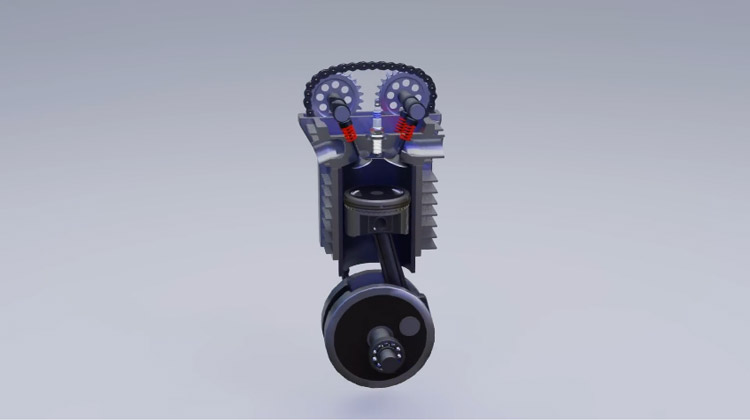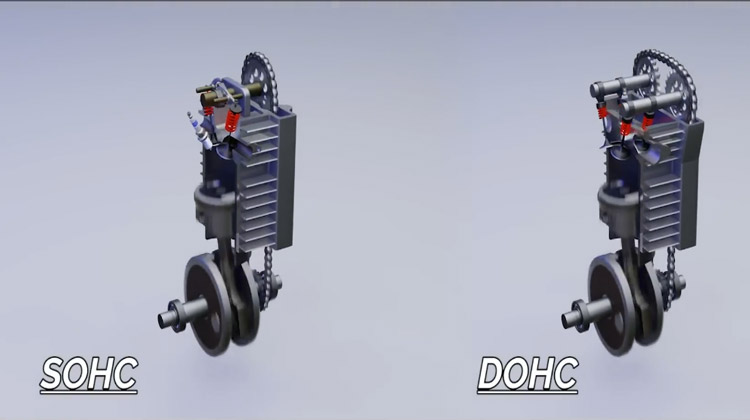If you’re in the market for a new car, you may be wondering which engine is right for you. There are two main types of engines: DOHC and SOHC. Both have their own advantages and disadvantages, so it can be difficult to decide which one is best for your needs. In this comparison, I will discuss the differences between DOHC and SOHC engines and help you decide which one is right for you!
DOHC vs SOHC: Detailed Comparison
There are several different types of engines available on the market today, each with its own benefits and drawbacks. Two of the most common types of engines are SOHC (single overhead camshaft) and DOHC (double overhead camshaft). Both types of engines have three main components in their head which control exhaust and intake.
You may be wondering what the difference is between SOHC and DOHC engines. While both have their pros and cons, below I will discuss which might fit your needs better. SOHC vs DOHC engine discussing downsides and upsides of each type so you can decide which suits you best.
SOHC: Single Overhead Camshaft Engine

SOHC, or Single Overhead Camshaft, is a type of engine that powers many vehicles. The SOHC can be found in both V and inline configurations. As the name implies, there is only one camshaft located atop the cylinders.
The camshaft turns as the engine is running. The valves controlling the mixture of air and fuel going into the cylinders, and exhaust gases leaving them, are opened and closed either by lifters or rocker arms actuated by the camshaft. So there can be no more than two valves per cylinder in a layout that otherwise resembles and operates like a pushrod engine.
The two valves are controlled at the same time, which makes SOHC engines work similarly to their pushrod counterparts. However, SOHCs are more reliable since there is no risk of floating or bent pushrods. A Single Overhead Camshafts engine uses a timing belt to keep the camshaft and crankshaft aligned. A SOHC 4 valve is also possible, but this creates a more complex combination of cam lobe shapes and rocker’s arms.
SOHC engines have advantages including being less expensive and easier to manufacture, plus they are lighter in weight. When it comes to needed maintenance, SOHC requires fewer parts overall which keep costs down.
DOHC: Dual Overhead Cam Engine

DOHC engines, more commonly known as Twin Cam, are becoming increasingly popular due to their efficiency. While they can work with either V-shaped or inline engines, DOHCs are most often used with Vs. This engine has two camshafts over the heads. Each cylinder has four valves, and an overhead camshaft controls every two of these valves.
The camshafts are positioned in pairs beside each other. The DOHC engine’s pistons can be separately adjusted from their mates, allowing more control and efficiency over the intake and exhaust process. The camshafts actuate the exhaust valves and intake valves, respectively. The extra camshaft in each cylinder row allows for more precise valve timing.
DOHC engines produce more power while also being more efficient than SOHC engines. Furthermore, DOHC engines run quietly and can endure high RPMs. These attributes have caused DOHC’s popularity to surge in the automotive industry as society increasingly demands lower exhaust emissions for a healthier economy.
While DOHC engines tend to be more complex and expensive, they are also difficult to repair and have high maintenance costs.
SOHC vs DOHC: What is the Difference?

Now that you understand the basics of SOHC and DOHC engines, it’s time to learn about the more intricate details that separate these two types of engines. After reading this, you’ll be able to make an informed decision on which engine is best for you.
1. Performance:
When it comes to performance, DOHC engines reign supreme. Due to their design, DOHC engines can handle more power and higher RPMs. The extra camshaft in each cylinder head allows for better airflow, which increases power and efficiency.
The primary distinction between DOHC and SOHC engines is power. Oftentimes, dual camshafts create more horsepower, which is why they’re frequently equipped in newer vehicles. This is because DOHC engines normally have 4 valves per cylinder instead of one intake and one exhaust like SOHC engines. Older cars didn’t have the same requirement for performance, so a single camshaft was sufficient.
2. Maintenance:
DOHC engines require more maintenance than SOHC engines. This is because DOHC engines are more complex, and they have more parts that can break down over time. Furthermore, DOHC engines are difficult to repair, which means you’ll likely have to take your car to a mechanic for service.
3. Cost:

DOHC engines are more expensive than SOHC engines. This is because they’re more complex and require more parts. Additionally, DOHC engines need to be serviced more frequently, which raises the overall cost of ownership.
4. Weight:
DOHC engines are heavier than SOHC engines. This is because they have more parts, and they’re typically made from heavier materials. The extra weight can negatively impact performance, but it’s often offset by the increased power of DOHC engines.
5. Fuel Efficiency:
DOHC engines are more fuel efficient than SOHC engines. This is because they’re better able to regulate airflow, which leads to improved combustion. Additionally, DOHC engines tend to have lower emissions, which is better for the environment.
Typically, a dual camshaft engine has better fuel efficiency than a single camshaft engine because there are more valves per cylinder. More performance can actually lead to lower fuel efficiency though. For example, this is often the case when you let an engine breathe properly since it’s much more efficient under those conditions.
6. Repair Costs:

DOHC engines are more expensive to repair than SOHC engines. This is because they’re more complex, and they have more parts that can break down over time. Furthermore, DOHC engines are difficult to repair, which means you’ll likely have to take your car to a mechanic for service.
Although DOHC engines boast more power, they also come with a greater number of valves, camshafts, and parts that can break down. In contrast, a single camshaft needs fewer components for the engine to run smoothly. If you prioritize reliability over performance, SOHC is likely the ideal option for you!
7. Durability:
DOHC engines are more durable than SOHC engines. This is because they’re made from higher quality materials, and they have a more robust design. Additionally, DOHC engines typically require less maintenance, which means they last longer.
8. Emissions:
DOHC engines produce lower emissions than SOHC engines. This is because they’re better able to regulate airflow, which leads to improved combustion. Additionally, DOHC engines tend to have lower emissions, which is better for the environment.
Pros And Cons of SOHC Engine:

Pros:
– More simple and therefore, easier (and cheaper) to maintain.
– Lighter weight results in better fuel economy.
Cons:
– Not as powerful as DOHC engines.
– Cannot handle as high of RPMs.
– More difficult to upgrade.
– Higher emissions output.
Pros And Cons of DOHC Engine:

Pros:
– More powerful than SOHC engines.
– Can handle higher RPMs.
– More upgrade options.
– Lower emissions output.
Cons:
– More difficult (and therefore, more expensive) to maintain.
– Heavier weight results in worse fuel economy.
SOHC or DOHC: Choose The Right Engine For Your Car

When choosing between a SOHC or DOHC engine, it’s important to consider your priorities. If you’re looking for an engine that is powerful and can be upgraded, DOHC is the way to go. However, if you’re looking for an engine that is cheaper to maintain and has better fuel economy, SOHC is the better option. Ultimately, the right engine for you depends on your needs and preferences.
Still, have any confusion? Watch the video below:
FAQs:
1. Why does DOHC make more power?
DOHC engines are more powerful than SOHC engines because they have more valves per cylinder. More valves mean more air can enter the cylinders, which leads to improved combustion. Additionally, DOHC engines typically have higher compression ratios, which also increases power.
2. Why is DOHC more fuel efficient?
DOHC engines are more fuel efficient than SOHC engines because they’re better able to regulate airflow. This leads to improved combustion, which means the engine doesn’t have to work as hard to produce power. Additionally, DOHC engines tend to have lower emissions, which is better for the environment.
3. How many camshafts does a dohc v8 have?
A DOHC v8 engine has 4 camshafts. 2 camshafts are located in the cylinder head, and each controls a set of valves. The other 2 camshafts are located in the block, and they actuate the pistons.
4. Is twin cam and SOHC the same?
No, twin cam and SOHC are not the same. Twin cam refers to an engine with 2 camshafts per cylinder, while SOHC refers to an engine with 1 camshaft per cylinder. Twin-cam engines are more powerful than SOHC engines, but they’re also more expensive to maintain.
5. What is the difference between DOHC and pushrod?
DOHC engines have 2 camshafts per cylinder, while pushrod engines have 1 camshaft per cylinder. DOHC engines are more powerful than pushrod engines, but they’re also more difficult to maintain. Additionally, DOHC engines typically have higher compression ratios, which means they’re more fuel efficient.
6. What is a cam-in-block engine?
A cam-in-block engine is a type of pushrod engine. This means that it has 1 camshaft per cylinder, and the camshaft is located in the block. Cam-in-block engines are typically less powerful than DOHC engines, but they’re also cheaper to maintain.
7. Can you change SOHC to DOHC?
Yes, you can change a SOHC engine to a DOHC engine. However, this is a significant upgrade, and it will likely be expensive. Additionally, it may not be worth the cost if your SOHC engine is already running well.
Conclusion:
DOHC engines are more powerful than SOHC engines, but they’re also more expensive to maintain. If you’re looking for an engine that is powerful and can be upgraded, DOHC is the way to go. However, if you’re looking for an engine that is cheaper to maintain and has better fuel economy, SOHC is the better option. Ultimately, the right engine for you depends on your needs and preferences.
I hope that my guideline helped you a better understanding of the difference between DOHC vs SOHC engines. If you have any questions, please feel free to ask in the comments below.
